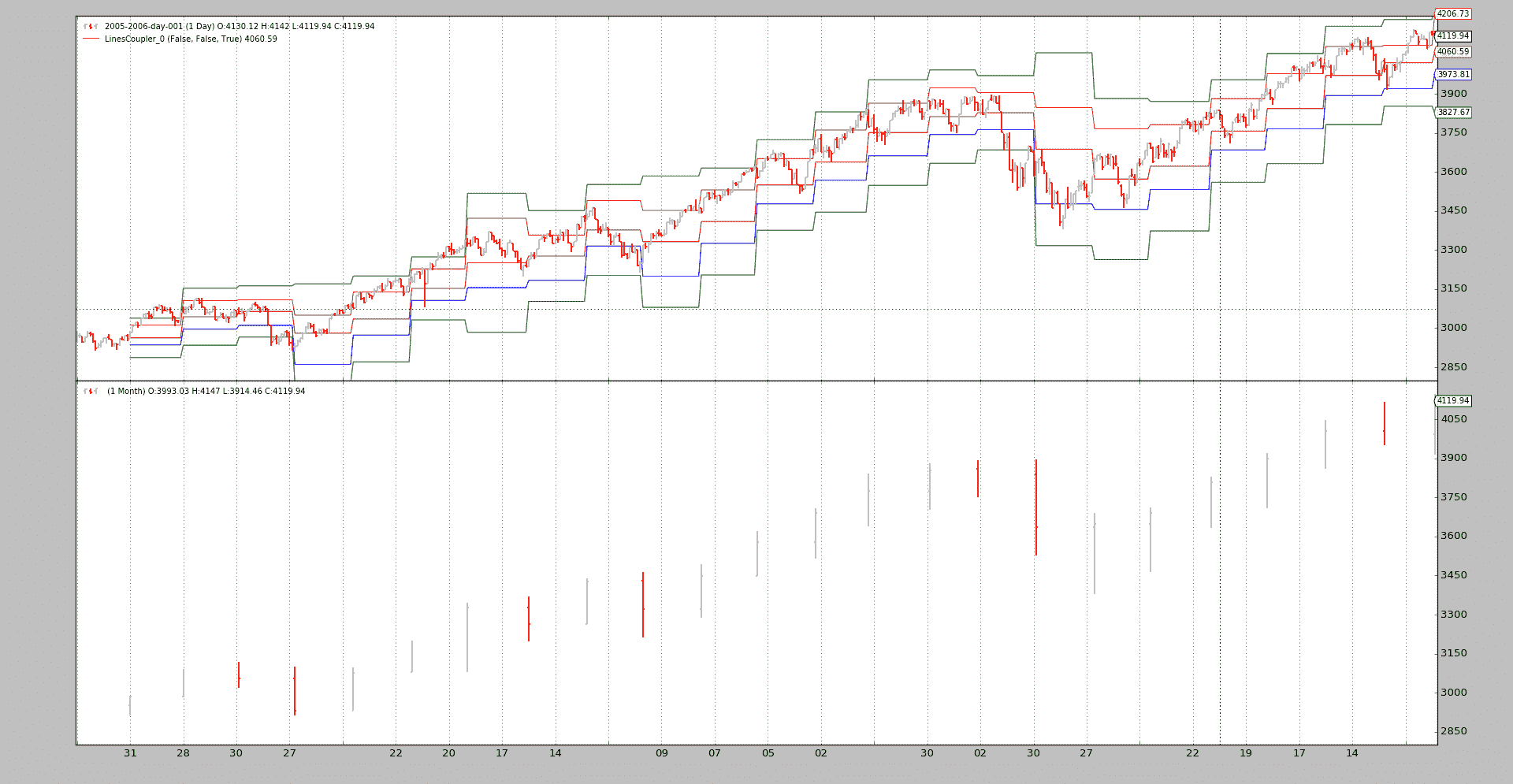在指标中混合时间框架
原文: https://www.backtrader.com/docu/mixing-timeframes/indicators-mixing-timeframes/
版本 1.3.0.92提出了将来自不同时间段的数据(来自数据源和/或指示器)混合的可能性。
背景:指示器是智能哑对象。
-
他们很聪明,因为他们可以进行复杂的计算。
-
他们之所以愚蠢,是因为他们不知道是什么来源为计算提供了数据
像这样的:
- 如果提供数值的数据源在
Cerebro引擎内具有不同的时间段、不同的长度,则指示器将断开。
计算示例,其中data0的时间段为天,data1的时间段为months:
pivotpoint = btind.PivotPoint(self.data1)
sellsignal = self.data0.close < pivotpoint.s1
在这里,当收盘价低于s1线(1st支撑时,寻求卖出信号
笔记
根据定义,PivotPoint在更大的时间范围内工作
这将在过去导致以下错误:
return self.array[self.idx + ago]
IndexError: array index out of range
还有一个很好的理由:self.data.close提供了从st瞬间开始的值,但PivotPoint(以及s1行)只会在整月过去后提供一次值,大约相当于self.data0.close的 22 个值。在此 22关闭期间,s1还没有一个值,尝试从基础阵列获取它失败。
行对象支持(ago)操作符(Python中的__call__特殊方法)来传递自身的延迟版本:
close1 = self.data.close(-1)
在本例中,对象close1(通过[0]访问时)始终包含close传递的先前值(-1。该语法已被重用,以适应适应时间范围。让我们重写上面的pivotpoint片段:
pivotpoint = btind.PivotPoint(self.data1)
sellsignal = self.data0.close < pivotpoint.s1()
查看如何在没有参数的情况下执行()(在后台提供了一个None)。发生了以下情况:
pivotpoint.s1()返回一个内部LinesCoupler对象,该对象遵循较大范围的节奏。此耦合器使用实际s1的最新传递值填充自身(从默认值NaN开始)
但是需要一些额外的东西才能让魔法发挥作用。Cerebro必须通过以下方式创建:
cerebro = bt.Cerebro(runonce=False)
或通过以下方式执行:
cerebro.run(runonce=False)
在该模式下,指示器和后期评估的自动行对象是逐步执行的,而不是紧密循环。这使整个操作变慢,但它使成为可能
底部的示例脚本在上面中断,现在运行:
$ ./mixing-timeframes.py
输出:
0021,0021,0001,2005-01-31,2984.75,2935.96,0.00
0022,0022,0001,2005-02-01,3008.85,2935.96,0.00
...
0073,0073,0003,2005-04-15,3013.89,3010.76,0.00
0074,0074,0003,2005-04-18,2947.79,3010.76,1.00
...
在第 74 行,close < s1的 1st实例发生。
该脚本还提供了对附加可能性的深入了解:耦合指示器的所有行。在我们之前:
self.sellsignal = self.data0.close < pp.s1()
作为替代方案:
pp1 = pp()
self.sellsignal = self.data0.close < pp1.s1
现在整个PivotPoint指示器已经耦合,可以访问其任何线路(即p、r1、r2、s1、s2)。脚本只对s1感兴趣,访问是直接的:
$ ./mixing-timeframes.py --multi
输出:
0021,0021,0001,2005-01-31,2984.75,2935.96,0.00
0022,0022,0001,2005-02-01,3008.85,2935.96,0.00
...
0073,0073,0003,2005-04-15,3013.89,3010.76,0.00
0074,0074,0003,2005-04-18,2947.79,3010.76,1.00
...
这一点也不奇怪。和以前一样。甚至可以绘制“耦合”对象:
$ ./mixing-timeframes.py --multi --plot
全耦合语法
对于具有多行的行对象(例如指示器如PivotPoint:
-
obj(clockref=None, line=-1)clockref如果clockref是None,则周围对象(在示例 aStrategy中)将作为参考,以适应较大的时间段(例如:Months)以适应较小/较快的时间段(例如:Days)
如果需要,可以使用另一个参考
line``py * If the default-1` is given, all lines are coupled.-
If another integer (for example,
0or1) a single line will be coupled and fetched by index (fromobj.lines[x]) -
If a string is passed, the line will be fetched by name.
In the sample, the following could have been done:
python coupled_s1 = pp(line='s1')py ```
对于具有单行的行对象(例如来自指示器PivotPoint的s1行):
obj(clockref=None)(见上文clockref)
结论
在常规的()语法中,来自不同时间段的数据馈送可以混合在指标中,始终考虑到cerebro需要实例化或使用runonce=False创建。
脚本代码和用法
在backtrader的来源中作为样品提供。用法:
$ ./mixing-timeframes.py --help
usage: mixing-timeframes.py [-h] [--data DATA] [--multi] [--plot]
Sample for pivot point and cross plotting
optional arguments:
-h, --help show this help message and exit
--data DATA Data to be read in (default: ../../datas/2005-2006-day-001.txt)
--multi Couple all lines of the indicator (default: False)
--plot Plot the result (default: False)
守则:
from __future__ import (absolute_import, division, print_function,
unicode_literals)
import argparse
import backtrader as bt
import backtrader.feeds as btfeeds
import backtrader.indicators as btind
import backtrader.utils.flushfile
class St(bt.Strategy):
params = dict(multi=True)
def __init__(self):
self.pp = pp = btind.PivotPoint(self.data1)
pp.plotinfo.plot = False # deactivate plotting
if self.p.multi:
pp1 = pp() # couple the entire indicators
self.sellsignal = self.data0.close < pp1.s1
else:
self.sellsignal = self.data0.close < pp.s1()
def next(self):
txt = ','.join(
['%04d' % len(self),
'%04d' % len(self.data0),
'%04d' % len(self.data1),
self.data.datetime.date(0).isoformat(),
'%.2f' % self.data0.close[0],
'%.2f' % self.pp.s1[0],
'%.2f' % self.sellsignal[0]])
print(txt)
def runstrat():
args = parse_args()
cerebro = bt.Cerebro()
data = btfeeds.BacktraderCSVData(dataname=args.data)
cerebro.adddata(data)
cerebro.resampledata(data, timeframe=bt.TimeFrame.Months)
cerebro.addstrategy(St, multi=args.multi)
cerebro.run(stdstats=False, runonce=False)
if args.plot:
cerebro.plot(style='bar')
def parse_args():
parser = argparse.ArgumentParser(
formatter_class=argparse.ArgumentDefaultsHelpFormatter,
description='Sample for pivot point and cross plotting')
parser.add_argument('--data', required=False,
default='../../datas/2005-2006-day-001.txt',
help='Data to be read in')
parser.add_argument('--multi', required=False, action='store_true',
help='Couple all lines of the indicator')
parser.add_argument('--plot', required=False, action='store_true',
help=('Plot the result'))
return parser.parse_args()
if __name__ == '__main__':
runstrat()


